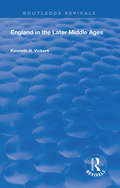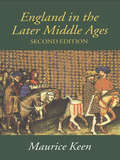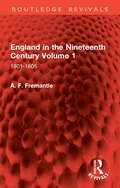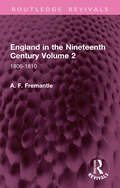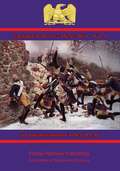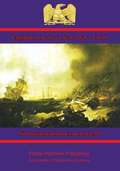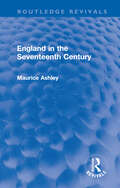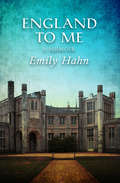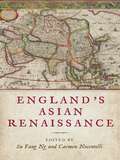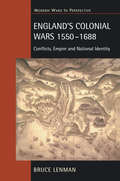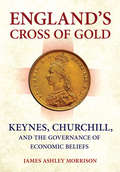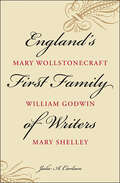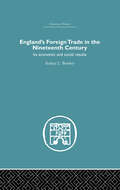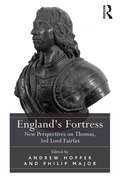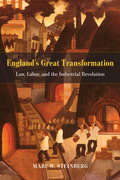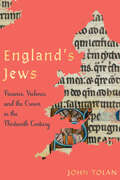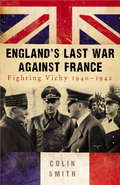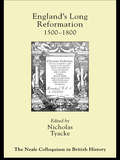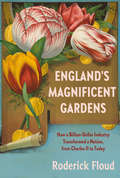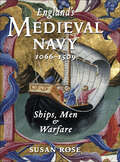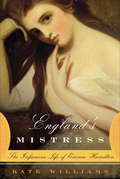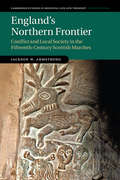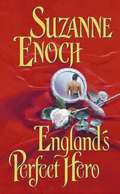- Table View
- List View
England in the Later Middle Ages (Routledge Revivals)
by K.H. VickersFirst published in 1950 in its 7th edition, this volume became a standard work. Covering 213 years, it begins with Edward I and proceeds through events including the Black Death and the Hundred Years War to Edward IV. In doing so, the author balanced political, constitutional, social and economic aspects of England’s national evolution.
England in the Later Middle Ages: A Political History
by M.H. KeenFirst published to wide critical acclaim in 1973, England in the Later Middle Ages has become a seminal text for students studying this diverse, complex period. This spirited work surveys the period from Edward I to the death of Richard III at the Battle of Bosworth, which heralded in the Tudor Age.The second edition of this book, while maintaining the character of the original, brings the study up to date. Each chapter includes a discussion of the historiographical developments of the last decade and the author takes a fresh look at the changing world of the Later Middle Ages, particularly the plague and the economy. Also included is a rewritten introduction.
England in the Nineteenth Century Volume 1: 1801-1805 (Routledge Revivals)
by A. F. FremantleOriginally published in 1929, this volume discusses the early effects of the industrial revolution – the condition of the cotton spinners, the hardships for labouring children, the overcrowded prisons and other brutal punishments. At this time the principal branch of local government was the Poor Law and this book discusses how, in the monumental task of providing workhouses for the destitute, the England of the eighteenth century had completely failed. As well as social history, the book also covers military and political history.
England in the Nineteenth Century Volume 2: 1806-1810 (Routledge Revivals)
by A. F. FremantleOriginally published in 1929, this volume discusses the early effects of the industrial revolution – the condition of the cotton spinners, the hardships for labouring children, the overcrowded prisons and other brutal punishments. At this time the principle branch of local government was the Poor Law and this book discusses how, in the monumental task of providing workhouses for the destitute, the England of the eighteenth century had completely failed. As well as social history, the book also covers military and political history.
England in the Seven Years War – Vol. I: A Study in Combined Strategy (England in the Seven Years War #1)
by Sir Llm. Julian Stafford CorbettThis ebook is purpose built and is proof-read and re-type set from the original to provide an outstanding experience of reflowing text for an ebook reader. The Seven Years War (1756-1763) was one of the truly world-wide conflicts following the expansion of European colonies, with engagements spanning from India to Canada. As with so many of the European wars, the causes were a question of land and legitimacy. The ever-present simmering tensions between England and France, and the newly emergent Prussia and Austria, led to a conflict that dragged many other nations into the strife. Notable in this war were the brilliance of Frederick, who would earn his title "the Great" during these wars, and the eclipse of Spain, Portugal and Sweden as powers of the first rank. However, the policy of England, that of Pitt, was to limit the commitment in terms of men; priority was given to the Royal Navy, and an indirect form of colonial warfare allied with blockade was established. The naval intricacies, along with their political and land-based military corollaries, are illuminated in Corbett's two volume history of the English contribution to the Seven Years war. This First volume in the series focusses on the actions to 1759, including the warfare in the Caribbean, around the French and German coast-lines, and the actions in and around Quebec, leading to that city's capture. Sir Julian S. Corbett was a prolific author and authority on British warfare and more particularly the naval aspects; he was also lecturer in history to the Royal Naval College. Title - England in the Seven Years War - Vol. I Sub-Title - A Study in Combined Strategy Series Name - England in the Seven Years War Series Number --1 Author -- Sir Julian Stafford Corbett, LLM. (1854-1922) Text taken, whole and complete, from the edition published in 1907, London, by Longmans, Green and Co. Original - xi and 476 pages. Illustrations - 10 maps and plans.
England in the Seven Years War – Vol. II: A Study in Combined Strategy (England in the Seven Years War #2)
by Sir Llm. Julian Stafford CorbettThis ebook is purpose built and is proof-read and re-type set from the original to provide an outstanding experience of reflowing text for an ebook reader. The Seven Years War (1756-1763) was the one of the truly world-wide conflicts, with engagements spanning from India to Canada. The causes, as with so many of the European wars, was a question of land and legitimacy, the ever present simmering tensions between England and France, and the newly emergent Prussia and Austria, leading to a conflict that dragged many other nations into the strife. Notable in this war were the brilliance of Frederick, who would earn his title "the Great" during these wars; and the eclipse of Spain, Portugal and Sweden as powers of the first rank. However, the policy of England - that of Pitt - was to limit the commitment in terms of men; priority was given to the Royal Navy, and an indirect form of colonial warfare allied with blockade was established. The naval intricacies, along with their political and land-based military corollaries, are illuminated in Corbett's two volume history of the English contribution to the Seven Years war. The second volume carries the narrative on into 1760: an abortive counter-attack by French forces in Canada; further pressure in Germany thwarted by Frederick and his generals; and the catastrophic intervention of Spain into the war. Sir Julian S. Corbett was a prolific author and authority on British warfare and more particularly the naval aspects; he was also lecturer in history to the Royal Naval College. Title - England in the Seven Years War - Vol. II Sub-Title - A Study in Combined Strategy Series Name - England in the Seven Years War Series Number --2 Author -- Sir Julian Stafford Corbett, LLM. (1854-1922) Text taken, whole and complete, from the edition published in 1907, London, by Longmans, Green and Co. Original - 389 pages. Illustrations - 4 maps and plans.
England in the Seventeenth Century (Routledge Revivals)
by Maurice AshleyOriginally published in 1952 but here reissuing the updated edition of 1978, this book has long been established as a classic and a central text for students of seventeenth-century English history. The book covers every aspect of English life from the arrival of James I in England to the death of Queen Anne. The chapters on political history are organized chronologically, interspersed with thematic chapters which analyse change and development in family and social life, literature and the arts, scientific and philosophical ideas and the growth of the first British Empire.
England on the Eve of Industrial Revolution
by Louis W. MoffitPublished in the year 1963, England on the Eve of the Industrial Revolution is a valuable contribution to the field of Economics.
England to Me: A Memoir (American Autobiography Ser.)
by Emily HahnAuthor of such celebrated and acclaimed works as The Soong Sisters, China to Me, and Fractured Emerald: Ireland, Emily Hahn has been called by the New Yorker &“a forgotten American literary treasure.&” Now Hahn is reintroduced to a new generation of readers, bringing to light her richly textured voice and unique perspective on a world that continues to exist through both history and fiction.It was August 2nd, 1946, when we arrived. The war was not so long over that we had shed every reminder of it, even in New York, and the Queen Mary was still fitted up as a troopship. From this opening, Emily Hahn&’s England to Me takes readers into a world filled with uncertainty as she tries to settle into the English countryside after her harrowing years in the Far East. From Southampton to London, here is a portrait of a country in flux, and of a woman of strong insight determined to find her place in it.
England's Asian Renaissance (The Early Modern Exchange)
by Jennifer Feather Amrita Sen Richmond Barbour Abdulhamit Arvas Thea Buckley Nedda Mehdizadeh Rachana Sachdev Emily SoonEngland's Asian Renaissance explores how Asian knowledges, narratives, and customs inflected early modern English literature. Just as Asian imports changed England's tastes and enriched the English language, Eastern themes, characters, and motifs helped shape the country's culture and contributed to its national identity. Questioning long-standing dichotomies between East and West and embracing a capacious understanding of translatio as geographic movement, linquistic transformation, and cultural grafting, the collection gives pride of place to convergence, approximation, and hybridity, thus underscoring the radical mobility of early modern culture. In so doing, England's Asian Renaissance also moves away from entrenched narratives of Western cultural sovereignty to think anew England's debts to Asia. Published by the University of Delaware Press. Distributed worldwide by Rutgers University Press.
England's Colonial Wars 1550-1688: Conflicts, Empire and National Identity (Modern Wars In Perspective)
by Bruce LenmanBruce Lenman's hugely ambitious study explores three interacting themes: the growth of England's sprawling colonial empire; its military dimension; and the impact of colonial warfare on national identity. He starts in Ireland, with the renewed assault of English settlers on the Irish Gaeltacht. Under the (Scottish) Stuarts, England then began a dramatic expansion across the North Atlantic. In America, the 'Indian Wars', fought with minimal Crown support, helped forge an independent military capability among the colonists; while, in the West Indies, slave numbers and French intervention forced English settlers into a new dependency on the Crown. In India, the East India Company achieved ascendancy by sepoy armies under British control. These were very different kinds of empire; and a showdown became inevitable. The climactic conflict, the American Revolution, would not only dictate the future shape of colonial expansion, but also decisively reshaped the identities of all the participants.
England's Cross of Gold: Keynes, Churchill, and the Governance of Economic Beliefs (Cornell Studies in Money)
by James Ashley MorrisonIn England's Cross of Gold, James Ashley Morrison challenges the conventional view that the UK's ruinous return to gold in 1925 was inevitable. Instead, he offers a new perspective on the struggles among elites in London to define and redefine the gold standard—from the first discussions during the Great War; through the titanic ideological clash between Winston Churchill and John Maynard Keynes; to the final, ill-fated implementation of the "new gold standard."Following World War I, Churchill promised to restore the ancient English gold standard—and thus Britain's greatness. Keynes portended that this would prove to be one of the most momentous—and ill-advised—decisions in financial history. From the vicious peace settlement at Versailles to the Great Depression, the gold standard was central to the worst disasters of the time. Economically, Churchill's move exacerbated the difficulties of repairing economies shattered by war. Politically, it set countries at odds as each endeavored to amass gold, sowing the seeds of further strife.England's Cross of Gold, grounded in masterful archival research, reveals that these events turned crucially on the beliefs of a handful of pivotal policymakers. It recasts the legends of Churchill, Keynes, and their collision, and it shows that the gold standard itself was a metaphysical abstraction rooted more in mythology than material reality.
England's First Family of Writers: Mary Wollstonecraft, William Godwin, Mary Shelley
by Julie A. CarlsonA collective consideration of Wollstonecraft, Godwin, and Shelley with “extended and sophisticated readings of many of [their] neglected works” (Choice).Life and literature were inseparable for Mary Wollstonecraft, William Godwin, and Mary Shelley. In England’s First Family of Writers, Julie A. Carlson demonstrates how and why the works of these individuals can best be understood within the context of the family unit in which they were created.The first to consider their writing collectively, Carlson finds in the Wollstonecraft-Godwin-Shelley dynasty a family of writers whose works are in intimate dialogue with each other. For them, literature made love and produced children, as well as mourned, memorialized, and reanimated the dead.Construing the ways in which this family’s works minimize the differences between books and persons, writing and living, Carlson offers a nonsentimental account of the extent to which books can live and inform life and death. Carlson also examines the unorthodox clan’s status as England’s first family of writers. She explores how, over time, their reception has evinced ongoing public resistance to those who critique family values.
England's Foreign Trade in the Nineteenth Century: Its Economic and Social Results
by A.L. BowleyFirst Published in 2005. Routledge is an imprint of Taylor & Francis, an informa company.
England's Fortress: New Perspectives on Thomas, 3rd Lord Fairfax
by Andrew Hopper Philip MajorOvershadowed in the popular imagination by the figure of Oliver Cromwell, historians are increasingly coming to recognize the importance of Thomas Fairfax, 3rd Lord Fairfax of Cameron, in shaping the momentous events of mid-seventeenth-century Britain. As both a military and political figure he played a central role in first defeating Charles I and then later supporting the restoration of his son in 1660. England’s Fortress shines new light on this significant yet surprisingly understudied figure through a selection of essays addressing a wide range of topics, from military history to poetry. Divided into two sections, the volume reflects key aspects of Fairfax’s life and career which are, nevertheless, as interconnecting as they are discrete: Fairfax the soldier and statesman, and Fairfax the husband, horseman and scholar. This fresh account of Fairfax’s reputations and legacy questions assumptions about neatly demarcated seventeenth-century chronological, geographic and cultural boundaries. What emerges is a man who subverts as much as he reinforces assumed characteristics of martial invincibility, political disengagement and literary dilettantism.
England's Great Transformation: Law, Labor, and the Industrial Revolution
by Marc W. SteinbergWith England’s Great Transformation, Marc W. Steinberg throws a wrench into our understanding of the English Industrial Revolution, largely revising the thesis at heart of Karl Polanyi’s landmark The Great Transformation. The conventional wisdom has been that in the nineteenth century, England quickly moved toward a modern labor market where workers were free to shift from employer to employer in response to market signals. Expanding on recent historical research, Steinberg finds to the contrary that labor contracts, centered on insidious master-servant laws, allowed employers and legal institutions to work in tandem to keep employees in line. Building his argument on three case studies—the Hanley pottery industry, Hull fisheries, and Redditch needlemakers—Steinberg employs both local and national analyses to emphasize the ways in which these master-servant laws allowed employers to use the criminal prosecutions of workers to maintain control of their labor force. Steinberg provides a fresh perspective on the dynamics of labor control and class power, integrating the complex pathways of Marxism, historical institutionalism, and feminism, and giving readers a subtle yet revelatory new understanding of workplace control and power during England’s Industrial Revolution.
England's Jews: Finance, Violence, and the Crown in the Thirteenth Century (The Middle Ages Series)
by John TolanIn 1290, Jews were expelled from England and subsequently largely expunged from English historical memory. Yet for two centuries they occupied important roles in medieval English society. England’s Jews revisits this neglected chapter of English history—one whose remembrance is more important than ever today, as antisemitism and other forms of racism are on the rise.Historian John Tolan tells the story of the thousands of Jews who lived in medieval England. Protected by the Crown and granted the exclusive right to loan money with interest, Jews financed building projects, provided loans to students, and bought and rented out housing. Historical texts show that they shared meals and beer, celebrated at weddings, and sometimes even ended up in bed with Christians.Yet Church authorities feared the consequences of Jewish contact with Christians and tried to limit it, though to little avail. Royal protection also proved to be a double-edged sword: when revolts broke out against the unpopular king Henry III, some of the rebels, in debt to Jewish creditors, killed Jews and destroyed loan records. Vicious rumors circulated that Jews secretly plotted against Christians and crucified Christian children. All of these factors led Edward I to expel the Jews from England in 1290. Paradoxically, Tolan shows, thirteenth-century England was both the theatre of fruitful interreligious exchange and a crucible of European antisemitism.
England's Lane
by Joseph ConnollyJim and Milly. Stan and Jane. Jonathan and Fiona. Winter, 1959.Three married couples: each living in England's Lane, each with an only child, and each attending to family, and their livelihoods--the ironmonger, the sweetshop and the butcher.Each of them hiding their lies, disguising sin, and coping in the only way they know how.
England's Last War Against France: Fighting Vichy 1940-42
by Colin SmithGenuinely new story of the Second World War - the full account of England's last war against France in 1940-42.Most people think that England's last war with France involved point-blank broadsides from sailing ships and breastplated Napoleonic cavalry charging red-coated British infantry. But there was a much more recent conflict than this. Under the terms of its armistice with Nazi Germany, the unoccupied part of France and its substantial colonies were ruled from the spa town of Vichy by the government of Marshal Philip Petain. Between July 1940 and November 1942, while Britain was at war with Germany, Italy and ultimately Japan, it also fought land, sea and air battles with the considerable forces at the disposal of Petain's Vichy French.When the Royal Navy sank the French Fleet at Mers El-Kebir almost 1,300 French sailors died in what was the twentieth century's most one-sided sea battle. British casualties were nil. It is a wound that has still not healed, for undoubtedly these events are better remembered in France than in Britain. An embarrassment at the time, France's maritime massacre and the bitter, hard-fought campaigns that followed rarely make more than footnotes in accounts of Allied operations against Axis forces. Until now.
England's Long Reformation: 1500 - 1800
by Nicholas TyackeEngland's Long Reformation" brings together a distinguished team of scholars, who seek to advance beyond current debates concerning the English Reformation. It puts the religious changes of the 16th century in longer perspective than has been traditional and counters the recent emphasis on the popularity of pre-Reformation Catholicism. Instead the case is argued for an underlying trajectory of evangelical activity from the 1520s. The contributors also examine some of the hybrid religious forms which developed and the propagation of the more uncompromising messages of Puritanism and Counter-Reformed Catholicism.; Taking their cue fom continental historians, the authors demonstrate the insights which can be derived by taking a long view of the Reformation in England. The processes of Protestantization and indeed Christianization were involved, with each new generation needing to be won over or at least re- educated. The interaction of religion and society - particularly as regards the so-called "reformation of manners" - is another central theme. Ranging from Tudor Norwich to Hanoverian Bristol, the work collectively breaks down some of the artificial barriers created by periodization and encourages a new way of looking at the English Reformation. This volume should prove valuable reading for those interested in the making of a Protestant nation.
England's Magnificent Gardens: How a Billion-Dollar Industry Transformed a Nation, from Charles II to Today
by Roderick FloudAn altogether different kind of book on English gardens—the first of its kind—a look at the history of England&’s magnificent gardens as a history of Britain itself, from the seventeenth-century gardens of Charles II to those of Prince Charles today. In this rich, revelatory history, Sir Roderick Floud, one of Britain&’s preeminent economic historians, writes that gardens have been created in Britain since Roman times but that their true growth began in the seventeenth century; by the eighteenth century, nurseries in London took up 100 acres, with ten million plants (!) that were worth more than all of the nurseries in France combined. Floud&’s book takes us through more than three centuries of English history as he writes of the kings, queens, and princes whose garden obsessions changed the landscape of England itself, from Stuart, Georgian, and Victorian England to today&’s Windsors. Here are William and Mary, who brought Dutch gardens and bulbs to Britain; William, who twice had his entire garden lowered in order to see the river from his apartments; and his successor, Queen Anne, who, like many others since, vowed to spend little on her gardens and instead spent millions. Floud also writes of Frederick, Prince of Wales, the founder of Kew Gardens, who spent more than $40,000 on a single twenty-five-foot tulip tree for Carlton House; Queen Victoria, who built the largest, most advanced and most efficient kitchen garden in Britain; and Prince Charles, who created and designed the gardens of Highgrove, inspired by his boyhood memories of his grandmother&’s gardens. We see Sarah, Duchess of Marlborough, who created a magnificent garden at Blenheim Palace, only to tear it apart and build a greater one; Deborah, Duchess of Devonshire, the savior of Chatsworth&’s 100-acre garden in the midst of its 35,000 acres; and the gardens of lesser mortals, among them Gertrude Jekyll and Vita Sackville-West, both notable garden designers and writers. We see the designers of royal estates—among them, Henry Wise, William Kent, Humphrey Repton, and the greatest of all English gardeners, &“Capability&” Brown, who created the 150-acre lake of Blenheim Palace, earned millions annually, and designed more than 170 parks, many still in existence today. We learn how gardening became a major catalyst for innovation (central heating came from experiments to heat greenhouses with hot-water pipes); how the new iron industry of industrializing Britain supplied a myriad of tools (mowers, pumps, and the boilers that heated the greenhouses); and, finally, Floud explores how gardening became an enormous industry as well as an art form in Britain, and by the nineteenth century was unrivaled anywhere in the world.
England's Medieval Navy, 1066–1509: Ships, Men & Warfare
by Susan RoseWe are accustomed to think of England in terms of Shakespeare's 'precious stone set in a silver sea', safe behind its watery ramparts with its naval strength resisting all invaders. To the English of an earlier period from the 8th to the 11th centuries such a notion would have seemed ridiculous. The sea, rather than being a defensive wall, was a highway by which successive waves of invaders arrived, bringing destruction and fear in their wake.Deploying a wide range of sources, this new book looks at how English kings after the Norman Conquest learnt to use the Navy of England, a term which at this time included all vessels whether Royal or private and no matter what their ostensible purpose to increase and safety and prosperity of the kingdom. The design and building of ships and harbour facilities, the development of navigation, ship handling, and the world of the seaman are all described, while comparisons with the navies of England's closest neighbours, with particular focus on France and Scotland, are made, and notable battles including Damme, Dover, Sluys and La Rochelle included to explain the development of battle tactics and the use of arms during the period. The author shows, in this lucid and enlightening narrative, how the unspoken aim of successive monarchs was to begin to build 'the wall' of England, its naval defences, with a success which was to become so apparent in later centuries.
England's Mistress: The Infamous Life of Emma Hamilton
by Kate WilliamsShe was the most famous woman in England–the beautiful model for society painters Joshua Reynolds and George Romney, an icon of fashion, the wife of an ambassador, and the mistress of naval hero Horatio Nelson. But Emma Hamilton had been born to the poverty of a coal-mining town and spent her teenage years working as a prostitute. From the brothels of London to the glittering court of Naples and the pretentious country estate of the most powerful admiral in England, British debut historian Kate Williams captures the life of Emma Hamilton with all its glamour and heartbreak. <P><P> In lucid, engaging prose, Williams brings to life a complex and intelligent woman. Emma is sensuous, generous, artistic, at once shamelessly seductive and recklessly ambitious. Willing to do anything for love and fame, she sets out to make herself a star–and she succeeds beyond even her wildest dreams. By the age of twenty-six, she leaves behind the precarious life of a courtesan to become Lady Hamilton, wife of Sir William Hamilton–the aging, besotted, and probably impotent British ambassador to the court of Naples.<P> But everything changes when Lord Nelson steams into Naples harbor fresh from his triumph at the Battle of the Nile and literally falls into Emma’s adoring arms. Their all-consuming romance–conducted amid the bloody tumult of the Napoleonic Wars–makes Emma an international celebrity, especially when she returns to England pregnant with Nelson’s baby.<P> With a novelist’s flair and an historian’s eye for detail, Williams conjures up the world that Emma Hamilton conquered by the sheer force of her charisma. All but inventing the art of publicity, Emma turned herself into a kind of flesh-and-blood goddess–celebrated by wits and artists, adored by thousands, and, for a time, very rich. Yet Emma was willing to throw it all away for the man she adored.<P> After four years of archival research and making use of hundreds of previously undiscovered letters and documents, Kate Williams sets the record straight on one of the most fascinating and ravishing women in history. England’s Mistress captures the relentless drive, the innovative style, and the burning passion of a true heroine.
England's Northern Frontier: Conflict and Local Society in the Fifteenth-Century Scottish Marches (Cambridge Studies in Medieval Life and Thought: Fourth Series #118)
by Jackson ArmstrongThe three counties of England's northern borderlands have long had a reputation as an exceptional and peripheral region within the medieval kingdom, preoccupied with local turbulence as a result of the proximity of a hostile frontier with Scotland. Yet, in the fifteenth century, open war was an infrequent occurrence in a region which is much better understood by historians of fourteenth-century Anglo-Scottish conflict, or of Tudor responses to the so-called 'border reivers'. This first book-length study of England's far north in the fifteenth century addresses conflict, kinship, lordship, law, justice, and governance in this dynamic region. It traces the norms and behaviours by which local society sought to manage conflict, arguing that common law and march law were only parts of a mixed framework which included aspects of 'feud' as it is understood in a wider European context. Addressing the counties of Northumberland, Cumberland and Westmorland together, Jackson W. Armstrong transcends an east-west division in the region's historiography and challenges the prevailing understanding of conflict in late medieval England, setting the region within a wider comparative framework.
England's Perfect Hero (Lessons in Love #3)
by Suzanne EnochLucinda Barrett's best friends ended up married to the men to whom they delivered their 'lessons in love'. So Lucinda decides to choose someone who definitely needs lessons, but someone who will not complicate her life. And that person is definitely not Robert Carroway. Robert is nothing if not complicated, and though he is the brother of a viscount, he rarely goes about society, and finds the weather and hat fashions ludicrous subjects for discussion. Robert is attracted to Lucinda's unpretentious ways, her serenity and her kindness. When she chooses someone for her love lessons, Robert offers to help her deliver her lessons, but sets out to convince the woman he has fallen for to take a chance on love ... and on him.
